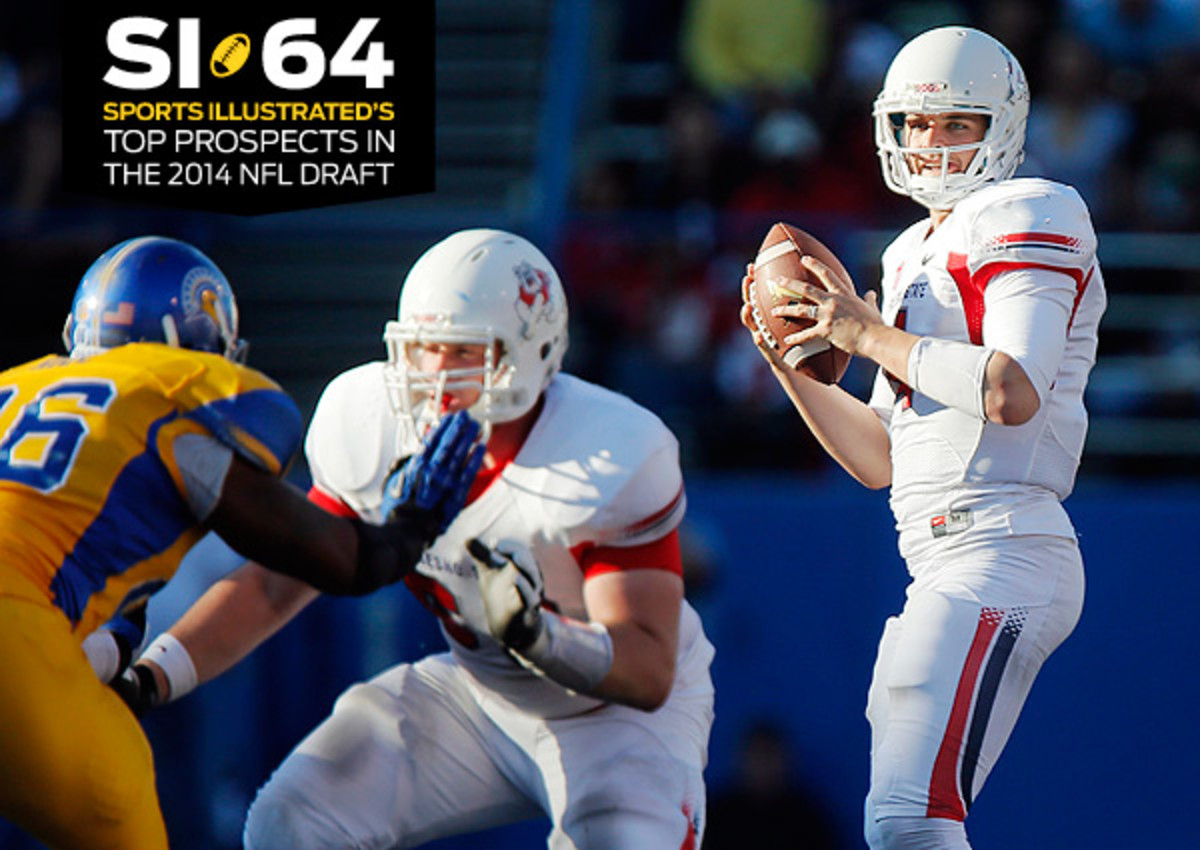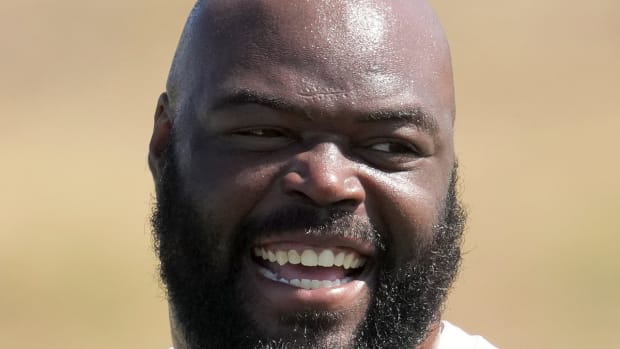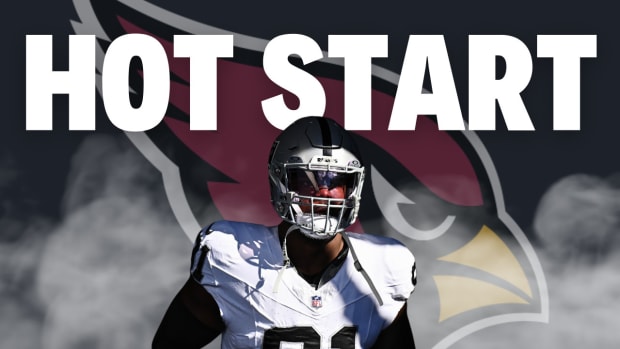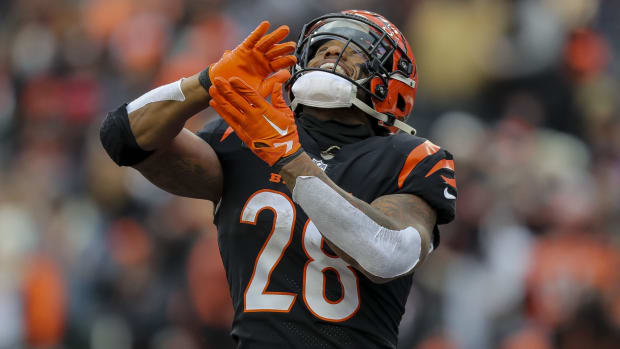The SI 64, Nos. 39-35: Lamarcus Joyner, Derek Carr, Allen Robinson and more
Derek Carr re-wrote record books at Fresno State, but can he adjust to a pro-style system? (Brian Bahr/Getty Images)
With the 2014 NFL draft fast approaching, it’s time for all 32 NFL teams to start getting their draft boards in order and ranking players based on their own preferences. At SI, it’s time for us to do that, as well. And to that end, Doug Farrar and Chris Burke have assembled their own definitive Big Board, consisting of the players they feel deserve to be selected in the first two rounds.
The SI 64, which recently covered prospects 44-40 and can be found in its entirety here, uses tape study to define the best prospects in this class, and why they’re slotted as such. Any of the five players spotlighted below could climb into Round 1, with a record-setting quarterback even carrying top-10 potential if the board falls just right.
MORE: 2014 NFL Mock Draft | Top TEs | Top guards | Top tackles | Top RBs
No. 39: Lamarcus Joyner, CB/S, Florida State
Bio: One of the most decorated players in all of college football last season, Joyner was a consensus All-ACC and All-America selection; a finalist for the Jim Thorpe Award, given to the nation's top defensive back; and a finalist for the Bronko Nagurski Award, honoring the FBS' best defensive player. All that after moving from safety to cornerback for the 2013 season. Joyner picked off a pair of passes in 2013 while notching 5.5 sacks. Prior to arriving at Florida State, Joyner was the high school USA Today National Defensive Player of the Year. His 5-foot-8 height has hardly proven to be a detriment thus far, but will the success continue at the next level?
Strengths: Shows a knack for reading plays, then digging his feet and driving on the football -- qualities that likely are fueling some of the chatter about a potential move to safety. Really dangerous as a blitzer off the edge, using his footspeed to close quickly on quarterbacks. Moved all over the field, in multiple coverages, though working the middle of the field in zone seemed to give him the best opportunity to make plays. Joyner willingly throws his shoulder into blocking backs, and he's not afraid of contact against the run. Chases the ball well. Just two interceptions, but forced several fumbles and was in position on countless plays.
Weaknesses: Protected some in Florida State's defense by a terrific front seven and help over the top. Even though he plays bigger than his size, Joyner's height probably limits him to a nickel-back spot or the safety position. Can be a little clunky turning to defend deep, though teams rarely tested him in such fashion. Needs a free release on the blitz or he can be negated rather easily. Same goes for Joyner's run defense -- he never stops working, but there were plenty of plays where he was unable to join the mix until the ballcarrier made it several yards downfield.
Conclusion: Much in the way that all smallish, athletic quarterbacks are drawing comparisons these days to Russell Wilson, players of Joyner's size and skillset are going to be lined up on the Tyrann Mathieu scale. The relation is rather apt here given Joyner's pros and cons. Like Mathieu, Joyner can be a dangerous weapon on special teams and plays a smart, aggressive style of football. And just like Mathieu, there will be issues against more powerful NFL-level players.
NFL player comparison: Tyrann Mathieu, Cardinals (3rd round, 2013, LSU)
No. 38: Derek Carr, QB, Fresno State
Bio: The stats for the two-time Mountain West Player of the Year are astounding. Last season alone, Carr completed 454 passes for 5,083 yards and 50 touchdowns -- all tops in the NCAA. In eight of Fresno State's 13 games, Carr topped 400 yards through the air, and surpassed the 500-yard total twice. Over back-to-back games against New Mexico and San Jose State, Carr threw for 13 total touchdowns. His numbers are among some of the most prolific all-time in FBS history. Of course, much of the credit there goes to the Bulldogs' playbook, which featured pass after pass after pass. Still, the 6-foot-3 Carr, brother of former No. 1 overall pick David Carr, made the offense go with his rifle arm.
Strengths: Be it on a deep ball, threading the needle in traffic or driving the football to the boundary, Carr has the coveted arm strength to get the football where it needs to go. As with others who have fallen into that elite-arm category, Carr can make up for some of his other mistakes simply by cranking up the velocity on his passes. A high-character guy: Carr was extremely respected in Fresno State's locker room and handled a difficult personal situation (his newborn son fell very ill) with a maturity beyond his years, while still leading the team. Smart before the snap, which will ease his NFL transition. Not anywhere near a scrambler, but Carr will get out of the pocket and keep his eyes downfield.
Weaknesses: Brings the negatives associated with that "gunslinger" mentality, namely that he will make mistakes attempting a gutsy play when there are safer options. Mechanics can break down, particularly when pressured. Has a tendency to cost himself accuracy by altering his arm slot -- Carr doesn't really come straight over the top as it is, something that could lead to passes being swatted at the line in the NFL. May need a little extra time to prep for an NFL offense, after a college career in Fresno State's pass-heavy attack.
Conclusion: Some may look at Derek's relation to David Carr as a curse; Derek has told anyone who will listen that it is just the opposite, that he has learned from his older brother's oft-miserable experience as an NFL starter. There is little doubt that the talent is here for Derek to enjoy more success. Of course, there also will be some frustrating moments for the team that picks him, just based on how he plays the game. Cleaning up his mechanics would eliminate some of those. The risk may be worth it, too, with so many positives to like.
NFL player comparison:Matthew Stafford, Lions (1st round, 2009, Georgia)
No. 37: Morgan Moses, OT, Virginia
Bio: Took over as a starter at right tackle in 2011, then shifted to the left side for his senior year. Moses is a hulking presence at 6-6 and 315 pounds with 35 3/8-inch arm length, all putting him in the wheelhouse for an NFL tackle. He said at the combine that he believes he could play all five positions along the line, shifting inside if teams prefer him there, though a move to center is extremely unlikely. Following a bit of a roller-coaster college career, Moses' draft status really began picking up steam at the Senior Bowl. Scouts came away from there impressed with how well he took advantage of his massive frame.
Strengths: Well, for starters, he's huge. Unless he loses his balance or allows defenders inside of him (more on that in a minute), Moses is almost impossible to work past on a pass-rush in time to generate any real problems. Actually drops well for a player carrying his height/weight combo, moving his feet and maintaining his position. That footwork serves him well when he's moving as a run blocker, too. The strength is there to be dominant when Moses can balance himself and extend his arms.
Weaknesses: Back to those balance issues ... they can take Moses out of a play, especially when he tries to move forward. Rather than bend and drive, he can be caught dipping forward. Far more troubling than that or any other criticism of his technique: Moses sometimes appeared disinterested, more so the further back into his tape one goes. Will make his initial push, then let up. Needs to better convert his size into forward momentum in the ground game. Right now, he's a stalemate-type there, as opposed to someone teams can move the sticks behind on a regular basis.
Conclusion: Moses' improvement, both in his blocking and his motor, as his career progressed hint that he may only be scratching the surface of what is in store. His size alone gives him a chance to stick as an NFL tackle for years. A team that wants to grind out wins on the ground may be better off turning elsewhere, because Moses is much further along as a pass-protector than as a mauler. A team may reach for him in Round 1, hoping to tap into the obvious potential.
NFL player comparison:Gosder Cherilus, Colts (1st round, 2008, Boston College)
No. 36: Allen Robinson, WR, Penn State
Bio: While the Big Ten may not be as pass-happy as some other conferences, Robinson still deserves plenty of kudos for leading the conference in receptions and yards two straight years. In 2012, he set the pace with 77 grabs for 1,018 yards and 11 TDs; last year, he went for 97-1,432-6. The latter performance earned him a first-team All-America spot. The 6-3 receiver recently turned in a stellar pro day (following a somewhat-disappointing combine): 42-inch vertical, 11-foot broad jump and a 40 time under 4.5. He also dropped 12 pounds between February and this week, from 220 down to 208.
Strengths: Really uses his body well -- almost single-handedly saved Penn State versus Michigan last year by making two difficult, contested deep catches by high-pointing the football over top of defensive backs. Does not hesitate to play a physical style, either after making catches or aiding in the run game. His time with Penn State's pro-style system gave him plenty of opportunities to do the latter. Better speed/elusiveness than he is given credit for, hence the Nittany Lions' frequent use of him on screens and hitch routes. One of those receivers who simply finds a way to make the plays his team needs him to make.
Weaknesses: The catch-and-run quickness may be there, but the deep speed has not been. Better improvising on the fly than actually pulling off sharp routes, an issue that could leave him covered often in the NFL. Every so often, will fail to watch the ball into his hands, instead turning his eyes upfield prematurely. Not enough here at the moment to consider Robinson a No. 1 receiver, so his draft ceiling may be limited to Round 2.
Conclusion: One of the more consistent offensive players in the entire draft (and a personal favorite), Robinson should make for a steady target as an NFL receiver. The team that drafts him may have to assist him in getting open early on, while he develops his routes. Robinson will not shy away from press coverage and he is extremely adept carving up zones. Taller, more physical cornerbacks may give him problems if he cannot create a free release. Even taking into account what may be lacking here, Robinson falling beyond Round 2 would be stunning.
NFL player comparison:Rueben Randle, Giants (2nd round, 2012, LSU)
No. 35: Travis Swanson, C, Arkansas
Bio: Swanson redshirted back in 2009, then proceeded to start every single game over his remaining four years with Arkansas. The 6-5, 315-pounder was one of the finalists for the Rimington Trophy, an award presented to college football's best center. Swanson left a little to be desired at the combine, especially with just 20 bench-press reps, lowest for any O-lineman. He bounced back nicely at Arkansas' pro day (though he did not re-test in any timed or lifting drills), flashing his talent in positional work.
Strengths: Scrappy and savvy. May not blow defenders off the ball, but he also does not allow himself to be pushed back into the pocket. Quick-footed enough to be effective sliding in protection or on the move in the run game. An option at guard as a rookie, even if he probably will settle in back at center eventually. Very experienced, and he puts the knowledge gained with that playing time to good use pre-snap.
Weaknesses: Combine weightlifting performance reminded scouts that they are not landing a bruising center here. Swanson can be overwhelmed by strong tackles -- there are a couple games from his Arkansas days where Swanson appeared unable to adjust to what he faced. Better moving horizontally than laterally, so don't expect to see him leveling too many guys on the second level.
Conclusion: The versatility Swanson carries will bump him up many boards -- he could hold his own at multiple interior-line spots and seems capable of fitting in either a zone- or man-blocking scheme. His physical attributes could be more of a sell for teams running zone than those in man. Carries a lot of intangibles that successful early 2013 picks like Travis Frederick and Kyle Long did, including the intelligence factor. Swanson will not fit every team. The one he does will be glad to have him.
NFL player comparison:Chris Myers, Texans (5th round, 2005, Miami)






































